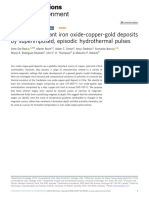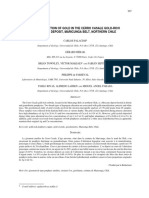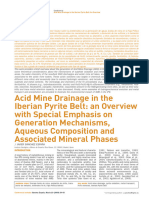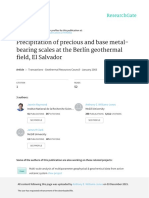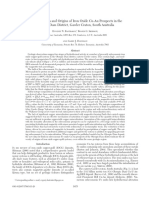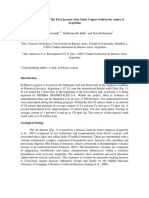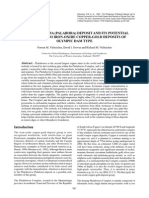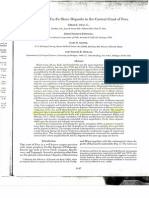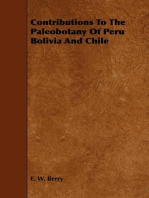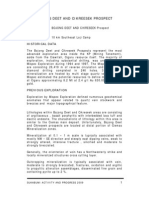Colquijirca-Epitermal y Cordillerano
Colquijirca-Epitermal y Cordillerano
Uploaded by
Miguel Quintana HernandezCopyright:
Available Formats
Colquijirca-Epitermal y Cordillerano
Colquijirca-Epitermal y Cordillerano
Uploaded by
Miguel Quintana HernandezOriginal Description:
Original Title
Copyright
Available Formats
Share this document
Did you find this document useful?
Is this content inappropriate?
Copyright:
Available Formats
Colquijirca-Epitermal y Cordillerano
Colquijirca-Epitermal y Cordillerano
Uploaded by
Miguel Quintana HernandezCopyright:
Available Formats
Miner Deposita (2008) 43:777789
DOI 10.1007/s00126-008-0195-1
ARTICLE
New 40Ar/39Ar alunite ages from the Colquijirca district,
Peru: evidence of a long period of magmatic SO2 degassing
during formation of epithermal AuAg and Cordilleran
polymetallic ores
Ronner Bendez & Laurence Page & Richard Spikings &
Zoltan Pecskay & Llus Fontbot
Received: 21 March 2007 / Accepted: 1 May 2008 / Published online: 15 July 2008
# Springer-Verlag 2008
Abstract We present 40Ar/39Ar data acquired by infra-red
(CO2) laser step-heating of alunite crystals from the large
Miocene Colquijirca district in central Peru. Combined with
previously published data, our results show that a long (at
least 1.3 My) and complex period of magmatic-hydrothermal
activity associated with epithermal Au(Ag) mineralization
and base metal, Cordilleran ores took place at Colquijirca.
The new data indicate that incursion of magmatic SO2bearing vapor into the Colquijirca epithermal system began
at least as early as 11.9 Ma and lasted until 10.6 Ma. Four
alunite samples associated with high-sulfidation epithermal
Au(Ag) ore gave 40Ar/39Ar plateau ages between 11.9 and
11.1 Ma (compared to the previously documented 11.6 to
11.3 Ma). By combining individually these new ages with
Editorial handling: F. Tornos
Electronic supplementary material The online version of this article
(doi:10.1007/s00126-008-0195-1) contains supplementary material,
which is available to authorized users.
R. Bendez (*) : R. Spikings : L. Fontbot
Section des Sciences de la Terre, Universit de Genve,
Geneva, Switzerland
e-mail: Ronner.Bendezu@terre.unige.ch
R. Bendez
Sociedad Minera El Brocal S. A. A.,
Lima, Peru
L. Page
Department of Geology, Lund University,
Slvegatan 12,
22362 Lund, Sweden
Z. Pecskay
Institute of Nuclear Research, Hungarian Academy of Sciences,
Bemtr 18/C,
4026 Debrecen, Hungary
crosscutting relationships, the duration of the Au(Ag)
deposition period can be estimated to at least 0.4 My. Three
new 40Ar/39Ar plateau ages on alunite associated with the
base-metal Cordilleran ores are consistent with previously
obtained ages, all of them between 10.830.06 and 10.56
0.06 Ma, suggesting that most of the sulfide-rich polymetallic deposits of Smelter and Colquijirca formed during this
short period. The recognition of consecutive alunite-bearing
and alunite-free mineral assemblages within both the Au
(Ag) and the base-metal Cordilleran ores may suggest that
SO2-bearing magmatic vapor entered the epithermal environment as multiple discontinuous pulses, a number of
which was not necessarily associated in time with ore fluids.
It is likely that a period of SO2-bearing vapor degassing
longer than 11.9 to 10.6 Ma may be recognized with further
more detailed work.
Keywords Epithermal . Alunite .
High sulfidation . 40Ar/39Ar geochronology . Cordilleran .
Colquijirca . Peru
Introduction
Hydrothermal systems with life spans over 1 My have been
documented for several major porphyry-related systems,
including Chuquicamata, El Teniente, Butte, La Escondida,
and Cerro de Pasco (Ossandn et al. 2001; Gustafson et al.
2001; Pcskay snd Molnr 2002; Heather et al. 2003;
Maksaev et al. 2003; Baumgartner et al. 2006; Baumgartner
2007). Several studies propose that long hydrothermal life
spans are the result of multiple pulses related to each one of
the single intrusions and which should not exceed durations
on the order of 50100 ky (e.g., Marsh et al. 1997; Henry
778
Miner Deposita (2008) 43:777789
et al. 1997; Muntean and Einaudi 2001; Seedorff et al.
2005). This paper is an attempt to identify such various
pulses in a porphyry-related epithermal environment comprising disseminated high-sulfidation Au(Ag) mineralization and Cordilleran polymetallic replacement deposits. The
study has been carried out in the well-exposed Miocene
Colquijirca district and includes infra-red (CO2) laser 40Ar/39Ar
analysis of alunite, as well as K/Ar analysis for samples in
which 40Ar/39Ar dating was not suitable. Crosscutting relationships at Colquijirca indicate that alunite, which was derived
from magmatic SO2-bearing vapors (see below), is pre-, syn-,
and post-Au(Ag) and Cordilleran mineralization, providing a
good opportunity to combine these relative ages with a highly
resolved geochronological data base.
The Colquijirca district
The Colquijirca district, located 12 km south of the Cerro de
Pasco district in central Peru (Fig. 1), contains two types of
GEOLOGICAL UNITS
Atacocha
MINERALIZATION TYPE
Quaternary deposits
Diatreme-dome complex (Miocene)
calcic skarn-related Zn-Pb-Ag
Dome complex (Late Eocene-Oligocene)
Pocobamba Formation (Eocene), mainly
limestones and marls
Chicrin limestone (Cretaceous)
Cordilleran base metal
(Zn-Pb-Cu-AgAu-Bi)
Au
epithermal
Milpo
Goyllarizquizga Group (Cretaceous), sandstones
360 000
Pucara Group (Upper Triassic-Lower Jurassic),
limestones and dolostones
Mitu Group (Permian-Triasssic), sandstones
Excelsior Group (Devonian), phyllites
3 Km
Pacoyn
Cerro de Pasco
Quicay
79
8820000
75
71
Yanamate
g
Lon
it u
di n
IQUITOS
t
aul
al f
CHICLAYO
CAJAMARCA
Colquijirca
8
TRUJILLO
Smelter
HUARAZ
PA
LIMA
CI
12
Marcapunta
FI
CUZCO
C
O
AREQUIPA
16
Fault
AREA OF
GEOLOGICAL MAP
Thrusts and
reverse faults
Folding axis
San Gregorio
E
A
N
Fig. 1 General geology and main mining centers in the Cerro de Pasco sector, central Peruvian Andes. Geology compiled from Johnson et al. (1955),
Angeles (1993), Sociedad Minera El Brocal S. A. A. staff, and this study
Miner Deposita (2008) 43:777789
epithermal mineralization: a disseminated high-sulfidation
Au(Ag) prospect (Oro Marcapunta) and Cordilleran polymetallic deposits (Colquijirca, Smelter, Marcapunta Oeste,
San Gregorio). We use the term Cordilleran polymetallic
deposits to underline that these deposits are sulfide rich,
contain ZnPbAg ores, and generally crosscut other styles
of porphyry-related epithermal mineralization.
The term Cordilleran deposit was introduced by Sawkins
(1972) and was subsequently used by Einaudi (1982),
Guilbert and Park (1985), Bartos (1987), Macfarlane and
Petersen (1990), Hemley and Hunt (1992), Bendez and
Fontbot (2002), Bendez et al. (2003), and Bendez (2007)
and Baumgartner (2007). Main features of Cordilleran basemetal deposits can be summarized as follows (modified from
Sawkins 1972 and Einaudi 1982): (1) close association in
time and space with calc-alkaline igneous activity, i.e., same
environment as most porphyry Cu and high-sulfidation
epithermal AuAg deposits; (2) deposition late in the
evolution of the porphyry system (as seen from abundant
cross-cutting relationships and sparse geochronological data
later than porphyry Cu, skarn, and high sulfidation Au (-Ag)
deposits). (3) deposition mostly under epithermal conditions
at shallow levels beneath the paleo-surface; (4) CuZnPb
(AgAuBi) metal suites, very rich in sulfides (up to more
than 50 wt.% total sulfides); (5) frequently, but not always,
well-developed zoning of ore and alteration minerals, cores
may show up to high-sulfidation and, though commonly this
is not the case (see below) advanced argillic alteration
assemblages; (6) frequent early pyritequartz stages with
low sulfidation assemblages containing pyrrhotite(arsenopyrite) that can be extensive and form large bodies zoned
outward to ZnPb ores; (7) mainly occurrence as open-space
fillings (veins, breccia bodies) in silicate host rocks and as
replacement in carbonate rocks. Another feature pointed out
below for Colquijirca is that Cordilleran ores display notably
higher Ag/Au ratios than high sulfidation epithermal Au
(Ag) mineralization. Cordilleran deposits have also been
termed as Butte-type vein deposits (Meyer et al. 1968),
polymetallic veins, and, recently, zoned base-metal veins
(Einaudi et al. 2003). We prefer the classical term Cordilleran
for this base metal mineralization related to pophyry systems
because not always the zoning is well developed, as it
depends of the host rock (better developed in carbonate
rocks) and of the sulfidation state of the fluid. Cordilleran
base-metal deposits have been historically an important
source of Cu and ZnPbAg in the North American
Cordillera (hence the name) and Peru. Currently, Cordilleran
ores represent the main source of zinc and lead of Peru,
which ranks within the top five producers worldwide in these
two metals.
The disseminated high-sulfidation Au(Ag) prospect and
the Cordilleran polymetallic deposits of the Colquijirca
district are spatially and temporally linked to a Miocene
779
diatremedome complex (Ahlfeld 1932; Lindgren 1935;
McKinstry 1936; Yaringao et al. 1997; Vidal et al. 1997;
Bendez 1997; Fontbot and Bendez 1999, 2001; Bendez
and Fontbot 2002; Bendez et al. 2003; Bendez 2007).
The Marcapunta diatremedome complex, exposed in the
center of the Colquijirca district (Sillitoe 2000; Bendez et al.
2003; Sarmiento 2004), is one of a series of Miocene
volcanic edifices, including Cerro de Pasco and Yanamate
(Fig. 1), which consist of multiple dome-lava intrusions of
mainly dacitic composition. Injection and explosion breccias
and pyroclastic layers, typical of diatreme conduits, are
extensively recognized at depth (Fig. 2). Inward-dipping normal faultlocated in peripheral areas suggest that the entire
edifice collapsed, likely prior to the main episodes of
mineralization (Fig. 3 in Bendez et al. 2003).
As in large sectors of Central Peru, the district is characterized by extensive exposures of carbonate rocks. A
400-m-thick sequence of limestone and dolostone of the Upper
TriassicLower Jurassic Pucar Group occupies the southern
and western sector of the Colquijirca district. The Eocene
Pocobamba Fm., with a thickness of up to 450 m and mainly
composed of continental marls and limestones (Angeles 1993),
covers most of the northern and eastern sector of the
Colquijirca district (Fig. 1).
The mining district was affected by Tertiary folding (NNE
fold axes), which predates the emplacement of the Marcapunta
volcanic complex (Angeles 1993). The major NS trending,
Longitudinal Fault (reverse fault), which has possibly been
active since the Jurassic (Angeles 1993), defines the eastern
border of the Colquijirca district and dissects the Cerro de
Pasco district to the north (Fig. 1). Other fracture systems
recognized in the Colquijirca district follow NWSE and NE
SW trends (Fig. 1). The Longitudinal Fault appears to control
the emplacement of the Miocene intrusive rocks, whereas
NWSE- and NESW-oriented fractures probably played a
significant role in channeling the ore fluids in much of the
district (Fig. 2). More details on the structural context of the
district are given in Bendez (2007).
The district hosts two main types of epithermal mineralization: (1) disseminated high-sulfidation Au(Ag) mineralization, hosted by volcanic rocks from the Marcapunta
complex, and (2) sulfide-rich Cordilleran polymetallic deposits hosted in the carbonate rocks of both the Pucar Group and
the Pocobamba Formation.
High-sulfidation epithermal Au(Ag) mineralization consists of oxide veinlets and disseminations hosted in vuggy
silica ledges. The vuggy silica ledges are zoned outward to
quartzalunite and to argillic alteration assemblages, which
affect most of the Marcapunta volcanic rocks. Typical gold
and silver concentrations in the vuggy silica ledges are on the
order of 0.23 and 1070 g/t, respectively (Vidal et al. 1997)
and Ag/Au ratios ranging from 10 to 30. The Au(Ag)bearing ledges display vertical dimensions of up to 100 m
780
Miner Deposita (2008) 43:777789
dacitic lava-domes
400 m
MARCAPUNTA OESTE
B
Eocene Pocobamba Formation
carbonate rocks (Calera Member)
MARCAPUNTA NORTE
Phreato-magmatic breccias
Cordilleran base metal ores
Enargite-pyrite-quartz-alunite(luzonite, colusite, zunyite
barite)
COLQUIJIRCA
A
Eocene Pocobamba Formation
carbonate rocks (Calera Member)
Eocene Pocobamba Formation carbonate rocks
(Shuco Member)
Pyrite-chalcopyrite-dickite-kaolinite-siderite-quartz
(tennantite, bornite, Bi-Ag sulphosalts, alunite, barite,
quartz)
Pyrite-sphalerite-galena-chalcopyrite-dickite-kaolinitequartz(siderite, hematite, magnetite, alunite),
and an outermost known zone of pyrite-galena-sphalerite
-siderite(kaolinite, dolomite, Zn-bearing carbonates).
high sulfidation epithermal Au-(Ag) mineralization
Au-(Ag)-bearing vuggy silica
Fig. 2 Block diagram illustrating the spatial relationships between the high-sulfidation epithermal Au(Ag) mineralization of Oro Marcapunta
and the Cordilleran base-metal deposits of Marcapunta Oeste, Smelter and Colquijirca (following the AB profile of Fig. 1)
and have been mainly recognized in the central portion of
the complex, associated with the diatreme breccia and
pyroclastic infill, where their morphology is controlled by
both lithological (phreatomagmatic breccias) and structural
permeability (EW fractures, Fig. 2). The deep portions of
vuggy silica ledges contain unoxidized Au(Ag) ores, which
contain less than 5 vol.% of finely disseminated sulfides, and
sulfide veinlets composed mainly of pyriteenargite and very
minor chalcocite, covellite, and sphalerite accompanied by
clays, largely kaolinite, but also smectite and/or illite. Vuggy
silica ledges and surrounding quartzalunite zones, which are
devoid of veinlets contain minor amounts of Au(Ag), suggesting that most of the precious metals precipitated during
veinlet formation. In several areas, quartzalunite alteration is
observed to postdate Au(Ag)-bearing veinlets (see below),
suggesting that several repeated episodes of vuggy silica
quartzalunite alteration and Au(Ag) deposition took place
at Marcapunta.
Cordilleran epithermal deposits mainly consist of Cu
ZnPbAg(AuBi)-zoned sulfide-rich replacements and
represent the economically most important type of mineralization in the district. Cordilleran mineralization aggregates to a resource of at least 220 Mt, including 130 Mt at
2% Cu from the Smelter deposit (Marcapunta Norte) and
the Marcapunta Oeste project and at least 90 Mt at 6% Zn,
2% Pb, and 3 oz/t Ag from the Colquijirca and San
Gregorio deposits (Yaringao et al. 1997; Vidal et al. 1997;
Vidal and Ligarda 2004). The historical ZnPb(Ag)
Colquijirca mine is located further to the north and has
been an important silver producer in Peru since pre-colonial
times (Hutchinson 1920; Lindgren 1935; McKinstry 1936;
Bendez 2007). The San Gregorio deposit, located 3 km
south of Marcapunta, was discovered during 19941995
and hosts at least 70 Mt at 7.3% Zn, 2.18% Pb, 0.57 oz/t Ag
(Yaringao et al. 1997), constituting the largest undeveloped
ZnPb(Ag) resource in the world. Mineralization at
Colquijirca, Smelter, and Marcapunta Oeste is mainly hosted
by the Pocobamba Fm., whereas the large San Gregorio
deposit replaces Pucar Group rocks.
A significant feature of the Colquijirca Cordilleran
deposits is the high total sulfide content, which fluctuates
between an average of 30 and 50 vol.%. The most abundant
minerals are pyrite, which crystallized during an Early
silicapyrite stage, followed in abundance by enargite
pyrite from the Main ore stage, and, finally, chalcocite from
the Late ore stage (Bendez 2007). Strongly oxidized
Miner Deposita (2008) 43:777789
781
Fig. 3 Images of alunite samples dated in this study. a Photomicrograph in transmitted light of sample PBR-336 showing alunite from
the high-sulfidation epithermal precious metal mineralization of Oro
Marcapunta. Note that it is devoid of pseudocubic cores of the
woodhouseitesvanvergite end-member. b Photograph of an outcrop
in southern Marcapunta in which plumose alunite (sample PBR-273)
cements Au(Ag) bearing rounded clasts (up to 2 ppm Au) of vuggy
silica formed from the epithermal precious metal system. c Small
geode displaying euhedral alunite intergrown with enargite plus minor
amounts of pyrophyllite and pyrite, Smelter Cordilleran ore (sample
PBR-322). d Photograph showing the effect of Cordilleran mineralization on volcanic rocks. A void left by former sanidine is filled by
platy euhedral alunite intergrown with quartz, pyrite, and enargite;
these last two, in addition, are in the form of veinlets and as coatings
in vugs. e Intimate intergrowth between alunite and sphalerite revealed
by backscattered electron image of sample PBR-298 from the
Cordilleran deposit of Colquijirca. f Backscattered electron image of
sample PBR-208 showing the typical extremely fine-grained habit of
alunite from the large Cordilleran deposit of San Gregorio
zones, originally composed of enargitepyrite, display Ag/
Au ratios ranging from 80 to 120, much higher than those
found in the Oro Marcapunta disseminated Au(Ag) ores
(10 to 20). Another major feature of Cordilleran mineralization in the Colquijirca district is the distinct ore zoning,
defined by (1) a Cu(AuAg) nucleus dominated by
enargite and usually accompanied by alunite-bearing
assemblages; (2) an intermediate Cu(ZnPbAgBi) zone
where chalcopyrite, sphalerite, and galena predominate; and
(3) an outer ZnPb(Ag) envelope mainly composed of
sphalerite and galena.
Cordilleran veins systematically cut the precious metal
veinlets and veins in the easternmost portion of the
Marcapunta Oeste project. This is observed in drill holes
CM3-444 and CM4-452, which encountered up to 350 m of
vertical sections containing Au(Ag) high-sulfidation epithermal ledges, which in the lowermost 50 m, are superimposed by Cordilleran ores (Bendez 2007). The quartz
alunite zones developed during the high-sulfidation epithermal event contain Au(Ag) veinlets, which were cut by
centimeter-wide pyrite(enargite)-rich veinlets and veins
generated during the Cordilleran event. Furthermore, a
majority of cavities within the vuggy silica contain
intergranular fillings of Cordilleran stage enargite, which
in part destroy earlier Au(Ag) veinlets with quartz
alunite-bearing assemblages.
782
The sulfur isotope composition of alunite from the
Colquijirca district indicates the alunite-bearing assemblages from the two epithermal mineralization types derived
from SO2-bearing magmatic vapors (Bendez 2007). The
34S values for alunite from both the high-sulfidation
Au(Ag) and the Cordilleran mineralization (from 21.1
to 26.4) are typical of hydrothermal magmatic fluids in
which sulfate has equilibrated with H2S formed through
disproportionation of SO2 within a condensing vapor
plume (e.g., Rye 1993).
Previous geochronologic data and scope
of the present work
Previous 40Ar/39Ar dating in the Colquijirca district using
furnace 40Ar/39Ar step-heating indicated that the Smelter and
Colquijirca Cordilleran deposits were formed by a late hydrothermal event, subsequent to the high-sulfidation epithermal Au(Ag) mineralization at Oro Marcapunta (Bendez et
al. 2003). Alunite samples related to the high-sulfidation
Au(Ag) system were dated at 11.60.08 to 11.30.06 Ma
(2) and those from the Cordilleran ores in the northern part
of the district (Smelter and Colquijirca) at 10.80.08 to 10.6
0.06 Ma.
According to the same survey, magmatic biotite derived
from flanking dacitic domes yielded 40Ar/39Ar ages ranging
from 12.90.10 to 12.40.04 Ma, which is 0.8 My older
than the earliest recognized hydrothermal manifestation (e.
g., alunite PBR-213 from the high-sulfidation epithermal
Au-(Ag) event dated at 11.630.08 Ma). Baumgartner
(2007) reports a slightly younger UPb age of 12.12
0.03 Ma for zircons from a dacitic dome from the western
sector of the Marcapunta volcanic complex.
The relatively long time gap between the two
epithermal events (0.5 My), interpreted by Bendez et
al. (2003) in terms of distinct hydrothermal events within
the same magmatic cycle and the gap between the youngest
dated magmatic dome and the oldest recognized hydrothermal manifestation (0.8 My) could be, in fact, an artifact due
the low quantity of age data. This paper examines also
these gaps on the basis of the new 40Ar/39Ar ages here
presented.
Dated samples
Seven platy, coarse-grained alunite separates were selected for
infra-red (CO2) laser step-heating 40Ar/39Ar analysis. Four
samples belong to the Oro Marcapunta high-sulfidation
epithermal Au(Ag) occurrence and three to the Cordilleran
epithermal ores of the northern part of the district (Smelter
and Colquijirca).
Miner Deposita (2008) 43:777789
Three whole-rock samples from the San Gregorio
Cordilleran deposit, in the southern part of the district,
were dated using the K/Ar method.
Alunite samples from the high-sulfidation epithermal
Au(Ag) mineralization
Alunite samples PBR-336 and PBR-338 of the Oro
Marcapunta high-sulfidation epithermal Au(Ag) mineralization were collected from the southern flank of the
southern topographic high of Marcapunta, approximately
400 m south of samples PBR-198 and PBR-214, which
were previously dated using furnace 40Ar/39Ar step-heating
(Bendez et al. 2003). They represent internal parts of
advanced argillic alteration zones (AAA zones), which
immediately envelope leached vuggy silica cores. In these
AAA zones, alunite is euhedral and dominantly accompanied by quartz (Fig. 3), though in some cases, pyrophyllite,
diaspore, and zunyite are locally important (Bendez 2007).
Samples PBR-336 and PBR-338 are cut by Au-bearing
veinlets composed mainly of oxides and minor jarosite and
quartz, indicating that precious metal deposition postdated
the advanced argillic alteration in the two points in which
the samples were collected. The dated alunite grains are less
than 1 mm long (Appendix 2), corresponding to the typical
grain size of alunite in the internal part of the AAA zones.
In contrast to alunite from the external parts of the AAA
zones, the dated alunite from internal zones is homogeneous, and no pseudocubic cores of the woodhouseite
svanvergite end-member were observed in thin section
(Fig. 3). The dated samples display minor Na substitution
by K (Na/K between 0.1 and 0.6, Table 1). The presented
Na/K ratios indicate that dated alunite samples are
compositionally close to the alunite end-member and that
natroalunite, which is often macroscopically mistaken for
alunite, was not recognized in this study.
The third Oro Marcapunta alunite separate (PBR-335)
was extracted from a vuggy silica rock in which alunite
occurs as thin coatings on cavities left by former sanidine
phenocrysts (Fig. 3). Alunite grains are, in this sample,
platy, euhedral, transparent, pinkish, and relatively coarse
(up to 3 mm long). They are all compositionally homogeneous and close to stoichiometric alunite (Table 1).
Sample PBR-273 from Oro Marcapunta contains plumose alunite. Individual alunite grains, which typically
occur in clusters within open-space fillings, are usually
longer than 1 cm across. In this sample, plumose alunite
cements a breccia, which contains rounded clasts of up to
more than 10 cm of vuggy silica containing Au(Ag)bearing oxide veinlets (Fig. 3). Selective chemical analysis
show that veinlets-bearing vuggy silica clasts are mineralized (up to 2 ppm Au), indicating that plumose alunite
postdated a period of gold deposition, which in turn
Miner Deposita (2008) 43:777789
783
Table 1 Representative microprobe composition of alunite from Au(Ag) and base-metal mineralization in the Colquijirca district
Sample
K2O
Na2O
BaO
SrO
PbO
Al2O3
SO3
P2O5
H2Oa
F
Total
High-sulfidation epithermal Au(Ag) ores
Cordilleran base-metal ores
PBR-273
PBR-335
PBR-336
9.89
0.82
0.43
0.82
0.00
35.98
40.21
0.12
14.02
0.18
102.47
9.78
0.81
0.38
0.32
0.02
35.88
39.90
0.23
14.24
0.07
101.63
8.22
1.78
0.25
0.02
0.01
37.20
38.86
0.24
11.86
0.76
99.20
PBR-298
PBR-322
PBR-208
10.04
0.24
0.26
0.02
0.01
36.79
39.01
0.14
11.96
0.69
99.16
8.85
2.04
0.16
0.51
0.01
35.94
40.84
0.24
11.84
2.42
102.85
9.21
0.42
0.08
0.16
1.32
36.42
40.80
0.82
12.62
0.38
102.23
Alunites were analyzed using a Cameca SX50 electron microprobe at the University of Lausanne. Instrumental conditions were accelerating
voltage of 12 kV, beam current of 10 nA, and spot size of 15 mm.
a
Weight percent H2O calculated based on observed values of sulfur, phosphorous, potassium, sodium, strontium, barium, and fluorine, and alunite
stoichiometry using the formula AR3(SO4)2(F, OH)6, in which A refers to the large cations K+, Na+, Ba2+, Pb2+, and Sr2+, and R is Al3+
postdated fine-grained quartzalunite alteration. Minor
quartz is the only accompanying phase and occurs as
euhedral grains encapsulated within the clusters of alunite.
An alunite grain from sample PBR-273 yielded compositions close to the alunite end-member, with an average Na/
K below 0.1 (Table 1).
Alunite samples from the Cordilleran epithermal
polymetallic deposits
Two of the three dated alunite samples extracted from the
Cordilleran epithermal polymetallic deposits were collected
from the internal parts of the Colquijirca deposit. Sample
PBR-244 belongs to the Cu(AuAg) zone of the Main
stage, which is dominated by enargite and includes abundant alunite and quartz, along with minor zunyite (Fig. 3).
Alunite is fine-grained (<500 m; Appendix 2) and fills
open spaces left by coeval pyrite, quartz, and enargite. In
places, minute inclusions of enargite float within alunite
masses. No microprobe data are available for these alunite
grains.
Alunite blades from sample PBR-298 were separated
from a rock belonging to the innermost portion of the
ZnPb(Ag) zone (i.e., the sphaleritegalena-rich part).
This type of assemblage, composed of alunitequartz
sphaleritegalenapyrite (kaolinitediaspore), is solely
found in portions immediately adjacent to the Cu-bearing
zones. The dated alunite occurs in open spaces intimately
intergrown with sphalerite, galena, pyrite, and quartz
(Fig. 3). Composition of alunite PBR-298 represents the
virtually pure K-rich end-member (Table 1).
The third sample (PBR-322) from the Cordilleran ores
was collected in the Smelter deposit where alunite occurs
together with silica (mainly quartz), enargite, zunyite
dickite. The dated alunite is intimately intergrown with
enargite (Fig. 3c), which is indicative to have precipitated
together from the Main ore stage (Bendez 2007). Alunite
of sample PBR-322 contains significantly more Na (up to
2.04 Na2O wt.%) than samples PBR-244 and PBR-298
(Table 1).
Two alunite-rich concentrates from fine-grained material composed of sulfides sphalerite and subordinate galena
and pyrite, kaolinite, quartz, and alunite of the San
Gregorio Cordilleran deposit were prepared (PBR-208
and PBR-284a). The grain size for all components is in
the order of several tens of microns, and alunite does not
exceed 30 m (Fig. 3; Appendix 2). Petrographic
observation (Fig. 3) does not show evidence of reaction
between alunite and sulfides and quartz. Furthermore,
alunite appears encroached into the sulfides and quartz,
and the reverse relationship is also recognized in other
samples. These observations suggest that alunite, sulfides
(including sphaleritegalena), and quartz precipitated
coevally, presumably from the same ore fluids. The
interpretation is supported by fluid inclusion data from
sphalerite and quartz, which share similar homogenization
temperatures and salinities (Bendez 2007). Microprobe
analyses of rare, large alunite grains (up to 100 m) yielded
bulk compositions close to stoichiometry, although in some
cases, the A site is occupied by significant amounts of Pb
(up to 1.32 wt.%, Table 1). Concentrate PBR-209 was
obtained from a 50-cm-thick vein, which cuts oxidized
784
Miner Deposita (2008) 43:777789
sulfide rock. Estimates of the composition of the three
concentrates, made using an optical binocular microscope,
are (in volume percent): PBR-208, 85% alunite, 10%
kaolinitequartz, 5% pyrite; PBR-209, 80% alunite, 10%
kaolinite, 5% anatase, 5% quartz; PBR-284a, 75% alunite,
15% pyrite-sphalerite, 10% quartzkaolinite.
Analytic procedure
Infra-red (CO2) laser
40
Ar/39Ar analysis
Step-heating 40Ar/39Ar analysis of alunite grains using a laser
have been reported by Mote et al. (2001) and Vasconcelos and
Conroy (2003). The significantly lower amount of material
(between 3 and 5 mg) required for laser degassing of alunite,
relative to conventional furnace heating, allows a more
specific sampling.
Alunite grains were individually handpicked from crushed
and washed samples following the procedure adopted for the
furnace 40Ar/39Ar analysis (Bendez et al. 2003). Only
grains of microscopically high purity (<2 vol.% of quartz
and opaque contaminants) were selected, obtaining for each
alunite separate between nearly 50 to several hundred grains,
depending on the granulometry of the quartzalunite as-
semblage. The grain separates were subsequently cleaned for
10 min in deionized water in an ultrasonic bath. Further
details of the alunite samples, including UTM coordinates
and sample amounts, are provided in Table 2. Alunite grains
selected for 40Ar/39Ar analysis were irradiated with the FCT
sanidine standard (28.020.16 Ma; Renne et al. 1998) for
8 h in the 1 MW, Cd-lined CLICIT facility at the University
of Oregon. The alunites and monitors were analyzed at the
40
Ar/39Ar laboratory of the University of Lund, Sweden. The
laboratory consists of a Micromass 5400 mass spectrometer,
equipped with a Faraday and an electron multiplier. The
stainless steel extraction line includes two SAES C50-ST101
ZrAl getters, and extracted gas was cooled to 150C by a
Polycold P100 cryogenic refrigeration unit mounted over a
cold finger. Single grains of alunite were step-heated using a
defocused 50-W CO2 laser rastered over the samples to
provide even-heating of the grains. Samples were measured
on the electron multiplier, and time-zero regressions were
fitted to data collected from ten scans over the m/e range of
4036. Peak heights and backgrounds were corrected for
mass discrimination, isotopic decay of 39Ar and 37Ar, and
interfering nucleogenic Ca-, K-, and Cl-derived isotopes.
The total decay constant for 40 K is that calculated by Stegier
and Jaeger (1977) at 5.543E10/a. The reactor irradiation
correction values are: (36Ar/37Ar)Ca, 2.69E4; (39Ar/37Ar)Ca,
Table 2 Summary of the dating results of the Colquijirca district
Sample
Location
Dacitic domes
Northern Marcapunta
PBR-148b
Western Marcapunta
PBR-215b
Huacchuacaja
PBR-216b
High-sulfidation epithermal Au(Ag) ores
Southern Marcapunta
PBR-273c
Central Marcapunta
PBR-338c
Central Marcapunta
PBR-335c
Central Marcapunta
PBR-336c
Central Marcapunta
PBR-198b
PBR-213b
Southern Marcapunta
Central Marcapunta
PBR-214b
Cordilleran base-metal ores
Smelter
PBR-322c
PBR-298c
Colquijirca
Colquijirca
PBR-244c
Colquijirca
PBR-108b
Smelter
PBR-131b
Smelter
PBR-137b
Colquijirca
PBR-218b
a
Plateau age calculated according to the criteria of Dalrymple and Lamphere (1971)
This study
c
Bendez et al. 2003
b
Dating results, error (Ma2)
Plateau agea
Inverse isochron age
12.430.06
12.40.1
12.90.1
12.70.1
11.510.06
11.100.06
11.690.06
11.900.07
11.330.14
11.630.08
11.290.12
11.440.13
11.150.07
11.730.07
11.790.07
11.40.1
11.60.1
11.30.1
10.640.06
10.760.06
10.750.06
10.590.08
10.830.06
10.560.08
10.720.06
10.750.07
10.600.08
10.60.1
10.90.1
10.60.1
10.70.1
Miner Deposita (2008) 43:777789
7.09E4; and (40Ar/39Ar)K, 16E4). 40Ar blanks were
calculated before every new sample and after every three
heating steps. 40Ar blanks were between 4.0 and 2.0E
16 mol. Blank values for m/e 39 to 36 were all less than 7E
18 mol. Age plateaus were determined using the criteria of
Dalrymple and Lamphere (1971), which specify the presence
of at least three contiguous incremental heating steps with
concordant ages that constitute >50% of the total 39Ar
released during the step-heating experiment. In addition,
ages have also been calculated with the inverse isochron
method (McDougall and Harrison 1999). Inverse isochron
diagrams allow to test the assumption made in the plateau
ages where any trapped non-radiogenic Ar has an atmospheric composition (40Ar/36Ar=295.5). The entire analytical process is automated and utilizes a software modified
specifically for this laboratory and originally developed at
the Berkeley Geochronology Center by Al Deino. 40Ar/39Ar
step-heating data, including heating schedules, are presented
in Appendix 1.
785
Atomic constants suggested by Steiger and Jger (1977)
were used for calculating the ages. All analytical errors
represent one standard deviation (i.e., 68% analytical confidence level). Since we base our analytical errors on the longterm stability of instruments and on the deviation of our
results obtained on standard samples from the interlaboratory
mean, the analytical errors are likely to be overestimated.
Results
40
Ar/39Ar data and age spectra are shown in Table 2 and
Fig. 4, respectively. Discussion is based on plateau ages. In
six of the seven dated samples, plateau ages are indistinguishable from the inverse isochron ages (at 2 analytical
uncertainties, Table 2). The 40Ar/39Ar intercepts on the inverse isochrones suggest that the initial argon reservoirs in
the alunite grains were atmospheric. Analytical data of conventional K/Ar dating are presented in Table 3, and errors
are reported at the 2 level.
K/Ar analysis
As indicated above, the fine-grained nature of the material
from San Gregorio prevented handpicking and 40Ar/39Ar
analysis. Therefore, alunite concentrates from San Gregorio
were prepared for K/Ar analysis. Concentrates were
achieved by centrifuging a crushed material immersed within
distillated water. Denser material rich in sulfide was
removed. The remaining fraction was then ultrasonically
cleaned, which additionally allowed separating part of the
residual contaminants, particularly pyrite. Any additional
treatment has not been carried out on the separates. As a
consequence, the purity of the alunites is only approximately
7585%. Mineralogical composition of the dated alunite
separates is given in Appendix 2.
For measurement of potassium concentration in alunite, an
aliquot of the final separate was grounded and reacted in a
Teflon container with HNO3 and HF at 120C. After evaporation of the acids, the sample was diluted by HCl solution,
and a Na buffer was added, and analyses have been made by
flame photometry. The analytical precision was 2% at the 1sigma confidence level.
For gas extraction, tantalum crucible was used, heated by
high frequency. Before degassing, 38Ar spike was added for
isotope dilution analysis. Purification was carried out in a
low-blank metallic line using titanium and SAES 707 getters
and cold trap.
Argon isotopic analyses were performed on-line in a 15-cm
radius sector type mass spectrometer equipped with a single
collector system. In all cases, mass discrimination factors for
Ar isotopes were determined using sample of atmospheric Ar.
Details of the instruments, the applied methods, and results of
calibration have been described elsewhere (Balogh 1985).
Alunite 40Ar/39Ar data from the Oro Marcapunta
high-sulfidation epithermal Au(Ag) mineralization
All four dated alunite samples related to the high-sulfidation
epithermal Au(Ag) mineralization yield age plateaus at
11.900.07 (PBR-336), 11.690.06 (PBR-335), 11.51
0.06 (PBR-273), and 11.10.06 Ma (PBR-338; Table 2,
Fig. 4, Appendix 1). These ages extend previous estimates
(11.290.1211.630.08 Ma; Bendez et al. 2003) of the
duration of acid-sulfate hydrothermal activity at Oro
Marcapunta by 0.5 My.
Alunite 40Ar/39Ar data from the Smelter and Colquijirca
Cordilleran deposits
Three alunite samples from the Cordilleran deposits yield
plateaus ages ranging between 10.640.06 and 10.76
0.06 Ma (PBR-244 from Colquijirca at 10.750.06 Ma;
PBR-298 from Colquijirca at 10.760.06 Ma; and PBR-322
from Smelter at 10.640.09 Ma; Fig. 4, Table 2). These new
data are consistent with mineralization ages presented by
Bendez et al. (2003) for other samples from Smelter and
Colquijirca (10.560.08 Ma, sample PBR-137 to 10.83
0.06 Ma, sample PBR-131).
Alunite K/Ar data from the San Gregorio
Cordilleran deposit
Alunite concentrates PBR-208 and PBR-284a of the San
Gregorio Cordilleran deposit yield similar K/Ar ages of 13.1
2.2 (PBR-208) and 13.22.2 Ma (PBR-284a; Table 3;
Fig. 5). The third alunite concentrate (PBR-209), extracted
786
Miner Deposita (2008) 43:777789
PBR-322
PBR-273
18
18
10.640.09 Ma
11.510.06 Ma
16
16
14
14
12
12
10
10
8
0
20
40
80
60
100
20
40
60
80
100
80
100
80
100
PBR-298
PBR-338
18
18
Apparent Age (Ma)
11.100.06 Ma
16
16
14
14
12
12
10
10
10.760.06 Ma
8
0
20
40
80
60
20
40
60
PBR-335
PBR-336
18
18
11.690.06 Ma
11.900.07 Ma
16
100
16
14
14
12
12
10
10
8
0
20
40
60
80
100
20
40
60
PBR-244
18
16
14
10.750.06 Ma
12
10
8
0
20
40
60
80
100
Cumulative %
39
Ar released
Fig. 4 40Ar/39Ar apparent age spectra from analyses through laser degassing. Step segments from which plateau ages were calculated are shown
in filled boxes
Miner Deposita (2008) 43:777789
787
Table 3 K/Ar data obtained on alunite separates
No. of K/Ar
Sample
6,092
6,095
6,093
PBR-208.
PBR-284a
PBR-209.
40
K (%)
7.76
5.24
6.27
Ar rad (ccSTP/g)
K/Ar age (Ma)
3.975106
2.696106
3.453106
3.404106
18.1
18.4
9.5
10
from a crosscutting vein, yielded in a first batch an age of
13.94.0 Ma (2). In order to confirm this apparent older
age, a duplicate analysis was made (14.14.2, no 6094). On
the basis of the mineralogical composition (Table 3), we can
exclude the presence of significant excess/inherited argon
caused by some detrital mica in this alunite concentrate.
Fig. 5 Summary diagram of
available geochronological data
(K/Ar and 40Ar/39Ar) from the
Colquijirca district, at 2 level
of confidence: (a) from Vidal et
al. (1984); (b) Bendez et al.
(2003)
40
Ar rad (%)
13.11.1
13.21.1
14.12.1
13.92.0
Discussion
According to the new infra-red (CO2) laser analysis of alunite
combined with the previously published data, a long (at least
1.3 My) and complex period of magmatic-hydrothermal
activity associated with Au(Ag) and Cordilleran ores took
Late Miocene
Middle Miocene
a
on biotite
a
on sanidine
a
on alunite
on alunitea
Dome emplacement
Previous surveys
K/Ara
39
40
Ar/ Ar (furnace)b
This survey:
39
Ar/ 40Ar (infrared laser)
K/Ar whole rock
High sulfidation epithermal
Au-(Ag) mineralization
San Gregorio
Cordilleran ores
Cordilleran base metal deposits
13
14
12
11
10
Age (Ma)
High sulfidation epithermal
Au-(Ag) mineralization
PBR-335
periods of Au-(Ag) deposition
of unknown duration
PBR-273
PBR-336
11.9
PBR-338
11.8
11.7
11.6
11.5
11.4
12
11.3
11.2
11.1
11
Age (Ma)
788
place at Colquijirca. The new data indicate that incursion of
magmatic SO2-bearing vapor into the Colquijirca epithermal
system began at least as early as 11.9 Ma, i.e., 0.3 My
earlier than the previously oldest recorded age at 11.6 Ma
and lasted until 10.6 Ma.
The four alunite samples associated with the highsulfidation epithermal Au(Ag) ores gave 40Ar/39Ar plateau
ages between 11.9 and 11.1 Ma (compared to the previously documented 11.6 to 11.3 Ma). Within this period
of alunite precipitation, two discrete pulses of Au(Ag)
deposition can be distinguished by combining individual
40
Ar/39Ar ages with crosscutting relationships. Since PBR273 plumose alunite cements clasts of vuggy silica which, in
turn, are cut by alunite-free Au(Ag)-bearing oxide veinlets,
an early Au(Ag) deposition pulse must have predated the
plumose alunite precipitation at 11.510.06 Ma. A younger
period of Au(Ag) deposition postdated the 11.10.06 Ma
age of PBR-338 alunite sample as the rock containing this
alunite is cut by Au(Ag)-bearing oxide veinlets. As far as
known to the authors, this is the first time that several Au
(Ag) deposition pulses have been discriminated in a highsulfidation epithermal Au(Ag) system. These two pulses
suggest a minimum duration of the Au(Ag) deposition of at
least around 0.4 My.
The recurrent acid sulfateAu(Ag) deposition events
distinguished in the Oro Marcapunta high-sulfidation
epithermal environment may represent shallow manifestations of repeated alterationmineralization events as recognized deeper in the porphyry environment elsewhere (e.g.,
Muntean and Einaudi 2001; Seedorff et al. 2005).
Generation of magmatichydrothermal acidic fluids continued in the Colquijirca system between 10.830.06 and
10.560.06 Ma as recorded by the three 40Ar/39Ar plateau
ages obtained on alunite related to the Cordilleran polymetallic ores. Because of the consistency of the ages yielded
by the seven analyzed alunite samples, which postdate and
are coeval with Cordilleran ores, it can be suggested that
probably most of the polymetallic deposition occurred during
the 10.83-to-10.56-Ma period.
The recognition of consecutive alunite-bearing and alunite-free mineral assemblages within both in the Au(Ag) and
in the Cordilleran ores may suggest that SO2-bearing
magmatic vapor entered the epithermal environment as multiple discontinuous pulses, a number of which was not
necessarily associated in time with ore fluids. It is likely that
a period of SO2-bearing vapor degassing longer than 11.9 to
10.6 Ma would be recognized if a more detailed work was
carried out.
Despite the large errors, the concordance of two of the
three KAr ages at 13.12.0 Ma obtained for the large San
Gregorio deposit in the southern part of the district opens
the possibility that the San Gregorio ore formation predates
the other known high-sulfidation systems in the Colquijirca
Miner Deposita (2008) 43:777789
district, including those of the Au(Ag) epithermal system
at Oro Marcapunta and the Cordilleran deposits of Smelter
and Colquijirca. According to this possibility, mineralization at San Gregorio may have been contemporaneous with
one or more of the episodes of dacitic doming such as that
dated at 12.90.1 Ma in the western flank of the Marcapunta
complex (biotite 40Ar/39Ar, sample PBR-215, Bendez et al.
2003).
Acknowledgments This work was supported by the Swiss National
Science Foundation (FN 2000-062000.00). We acknowledge also the
logistical support of Sociedad Minera El Brocal S.A.A. Reviews and
comments by Richard Sillitoe, Kurt Friehauf, and Torsten Vennemann of
a preliminary version of this paper as part of the PhD study by the seniors
author significantly improved the manuscript. Antonio Arribas and an
anonymous reviewer are thanked for their critical and constructive
comments that helped to improve the paper. The comments of Bernd
Lehmann are also appreciated.
References
Ahlfeld F (1932) Die Silberzlagersttte Colquijirca, Per. Zeitschrift
Praktische Geologie 40:8187
Angeles C (1993) Geologa de Colquijirca y alrededores. Informe
privado Sociedad Minera El Brocal S.A., p 39
Balogh K (1985) K/Ar dating of Neogene volcanic activity in
Hungary: Experimental technique, experiences and methods of
chronologic studies. ATOMKI Rep D 1:277288
Bartos PJ (1987) Quiruvilca, Peru: mineral zoning and timing of wallrock alteration relative to Cu-Pb-Zn-Ag vein-fill deposition. Econ
Geol 82:14311452
Baumgartner R (2007) The Cerro de Pasco Cordilleran base metal
deposit, central Peru. University of Geneva, PhD thesis
Baumgartner R, Fontbot L, Page L, Schaltegger U, Spikings R
(2006) Protracted high sulfidation hydrothermal activity: 40Ar/
39Ar and UPb geochronology at Cerro de Pasco, Central Peru.
SEG conference, Keystone, May 1215, 2006
Bendez R (1997) Caractersticas geolgicas mineralgicas y geoqumicas de los yacimientos de ZnPb (Ag) de San Gregorio y
Colquijirca emplazados en unidades sedimentarias en los bordes
del sistema epitermal de alta sulfuracin de Marcapunta. Tesis
Ingeniero, Universidad Nacional de Ingeniera, Lima, p 60
Bendez R (2007) Shallow polymetallic and precious metal mineralization associated with a Miocene diatremedome complex: The
Colquijirca district in the Peruvian Andes. University of Geneva,
Terre & Environnement volume 64. PhD thesis 3779, p 221
Bendez R, Fontbot L (2002) Late timing for high sulfidation
Cordilleran base metal lode and replacement deposits in
porphyry-related districts: the case of Colquijirca, Central Peru
SGA News 13:1, 913. (also accessible under http://www.unige.
ch/sciences/terre/mineral/ore/min_ore.htm)
Bendez R, Fontbot L, Cosca M (2003) Relative age of Cordilleran
base metal lode and replacement deposits and high sulfidation
Au(Ag) epithermal mineralization in the Colquijirca mining
district, central Peru. Mineralium Deposita 38:683694
Dalrymple GB, Lanphere MA (1971) 40Ar/39Ar technique of KAr
dating; a comparison with the conventional technique. Earth
Planet Sci Lett 12:300308
Einaudi MT (1982) Description of skarns associated with porphyry
copper plutons, southwestern North America. In: Titley SR (ed)
Advances in geology of the porphyry copper deposits, south
Miner Deposita (2008) 43:777789
western North America. University of Arizona Press, Tucson, pp
139184
Einaudi MT, Hedenquist JW, Inan EE (2003) Sulfidation state of
hydrothermal fluids: the porphyry-epithermal transition and
beyond. In Simmons SF, Graham IJ (eds) Volcanic, geothermal
and ore-forming fluids: rulers and witnesses of processes within
the Earth. Soc Econ Geologists Geochem Soc, Special Publication
10:285313
Fontbot L, Bendez R (1999) The carbonate hosted ZnPb San
Gregorio deposit, Colquijirca District, central Peru, as part of a
high sulfidation epithermal system. In Stanley et al. (eds) Fifth
Biennial SGA Meeting, Mineral Deposits: Processes to Processing 1:495498
Fontbot L, Bendez R (2001) The carbonate-hosted San Gregorio
and Colquijirca (Zn-Pb-Ag) deposits (central Peru) as products of
an epithermal high sulfidation system. Proexplo 2001, Lima,
Per, Abril 2001, CD-ROM, doc. 18 p
Guilbert JM, Park Jr. CF (1985) The Geology of ore deposits,
Freeman and Company, New York, 985 p
Gustafson LB, Orquera W, McWilliams M, Castro M, Olivares O,
Rojas G, Maluenda J, Mendez M (2001) Multiple Centers of
Mineralization in the Indio Muerto District, El Salvador, Chile.
Econ Geol 96:325350
Heather K, Leach T, Clark AH, Staff of the Compaa Minera El
Indio, Barrick Chile Ltda (2003) Geology of the El Indio Au
CuAg deposit: the final chapter? 10th Congreso geolgico
chileno, Conception, abstract volume: 1 p
Hemley JJ, Hunt JP (1992) Hydrothermal ore-forming processes in the
light of studies in rock-buffered systems, II. Some general
geologic applications. Econ Geol, 87:2343
Henry CD, Elson HB, McIntosh WC, Heizler MT, Castor SB (1997)
Brief duration of hydrothermal activity at Round Mountain,
Nevada determined from 40Ar/39Ar geochronology. Econ Geol
92:807826
Hutchinson WS (1920) The Fernandini properties, province of Pasco,
Peru: production costs and profits, Colquijirca silver mine,
Huaraucaca metallurgical plant, La Curena copper mine, San
Gregorio bismuth mine. Report for the Fernandini Properties, p 70
Johnson RF, Lewis RW Jr, Abele G (1955) Geology and ore deposits
of the Atacocha District, Departamento de Pasco, Peru. Geological Survey Bull 975-E:337388
Lindgren W (1935) The silver mine of Colquijirca, Per. Econ Geol
30:331346
MacFarlane AW, Petersen U (1990) Pb isotopes of the Hualgayoc
area, Northern Peru: Implications for metal provenance and
genesis of a Cordilleran polymetallic mining district. Econ Geol
85:13031327
Maksaev V, Munizaga F, McWilliams M, Mathur A, Ruiz J, Fanning M
(2003) Implication of isotope age data for the origin and evolution of
the El Teniente giant porphyry CuAu deposit, Chilean Andes. 10th
Congreso geolgico chileno, Conception, abstract volume: 1 p
Marsh TM, Einaudi MT, McWilliams M (1997) 40Ar/39Ar geochronolgy of CuAu and AuAg mineralization in the Potrerillos
district, Chile. Econ Geol 92:784806
McDougall I, Harrison TM (1999) Geochronology and Thermochronology by the 40Ar/39Ar Method. Oxford University Press,
Oxford
789
McKinstry HE (1936) Geology of the silver deposit at Colquijirca,
Per. Econ Geol 31:619635
Meyer C, Shea EP, Goddard CC Jr, STAFF (1968) Ore deposits at
Butte, Montana. In Ridge, JD (ed) Ore deposits of the United
States, 19331967 (Graton-Sales vol.). New York, American
Institute of Mining and Metallurgical Engineering, 2:13631416
Mote TI, Becker TA, Renne PR, Brimhall GH (2001) Chronology of
exotic mineralization at El Salvador, Chili by dating of copper
wad and supergene alunite. Econ Geol 96:351366
Muntean JL, Einaudi MT (2001) Porphyryepithermal transition:
Maricunga belt, Northern Chile. Econ Geol 96:743772
Ossandn C, Freraut CR, Gustafson LB, Lindsay DD, Zentilli M
(2001) Geology of the Chuquicamata mine. A Progress Report
Pcskay Z, Molnr F (2002) Relationships between volcanism and
hydrothermal activity in the Tokaj Mountains, Northeast
Hungary, based on KAr ages. Geologica Carpathica 53:5,
303314
Renne PR, Swisher CC, Deino AL, Karner DB, Owens TL, DePaolo
DJ (1998) Intercalibration of standards, absolute ages and
uncertainties in 40Ar/39Ar dating. Chem Geol 145:117152
Rye RO (1993) The evolution of magmatic fluids in the epithermal
environment: the stable isotope perspective. SEG Distinguished
Lecture. Econ Geol 88:733753
Sarmiento J (2004) Domos de lava relacionadas a la diatrema principal
en centro volcnico Marcapunta, Distrito Minero de ColquijircaPeru Central. Tesis Ingeniero, Universidad Nacional San Antonio
Abad del Cuzco, p 86
Sawkins FJ (1972) Sulfide ore deposits in relation to plate tectonics:
Jour. Geology 80:377396
Seedorff E, Dilles JH, Proffett JM, Einaudi MT, Zurcher L, Stavast
WJA, Johnson DA, Barton MD (2005) Porphyry deposits:
characteristics and origin of hypogene features. Econ Geol
100:251298 One Hundred Anniversary Volume
Sillitoe RH (2000) Zinc Exploration at Colquijirca, Central Peru.
Private report for Compaa de Minas Buenaventura S. A., p 9
Steiger RH, Jaeger E (1977) Subcommission on geochronology:
Convention on the use of decay constants in geo- and
cosmochronology. Earth Planet Sci Lett 36:359362
Vasconcelos PM, Conroy M (2003) Geochronology of weathering and
landscape evolution, Dugald River valley, NW Queensland,
Australia. Geochimica et Cosmochimica Acta 67:29132930
Vidal C, Ligarda R (2004) Enargite-gold deposits at Marcapunta,
Colquijirca Mining District, Central Peru: mineralogic and
geochemical zoning in subvolcanic, limestone-replacement
deposits of high-sulfidation epithermal type. Econ Geol Special
Publications 11:231242
Vidal C, Proao J, Noble N (1997) Geologa y distribucin
hidrotermal de menas con Au, Cu, Zn, Pb y Ag en el Distrito
Minero Colquijirca, Pasco. IX Congreso Peruano de Geologa:
217219
Vidal C, Mayta O, Noble DC, McKee EH (1984) Sobre la evolucin
de las soluciones hidrotermales dentro del centro volcnico
Marcapunta en Colquijirca-Pasco. Volumen Jubilar Sociedad
Geolgica del Per 10:114
Yaringao M, Arias W, Panz M (1997) Exploraciones y evaluacin
de los yacimientos del Distrito Minero de Colquijirca, Pasco. IX
Congreso Peruano de Geologa:231236
You might also like
- Formation of Giant Iron Oxide-Copper-Gold Deposits by Superimposed, Episodic Hydrothermal PulsesNo ratings yetFormation of Giant Iron Oxide-Copper-Gold Deposits by Superimposed, Episodic Hydrothermal Pulses9 pages
- Alunite and The Role of Magmatic Fluids in The Tambo Deyell2005No ratings yetAlunite and The Role of Magmatic Fluids in The Tambo Deyell200534 pages
- Sillitoe, 2003. Iron Oxide-Copper-Gold Deposits An Andean View100% (3)Sillitoe, 2003. Iron Oxide-Copper-Gold Deposits An Andean View26 pages
- Sillitoe 2003 Iron Oxide Copper Gold Deposits An Andean ViewNo ratings yetSillitoe 2003 Iron Oxide Copper Gold Deposits An Andean View50 pages
- Chamberlain 2007. Toward An Integrated Model For Alkalic Porphyry Copper Deposits PDFNo ratings yetChamberlain 2007. Toward An Integrated Model For Alkalic Porphyry Copper Deposits PDF16 pages
- Corbett Epithermal 2006 Paper 2nd DraftNo ratings yetCorbett Epithermal 2006 Paper 2nd Draft32 pages
- Efficient Extraction of Copper and Zinc From Seafloor Massive Sulphide Rock Samples From The Loki's Castle Area at The Arctic Mid-Ocean RidgeNo ratings yetEfficient Extraction of Copper and Zinc From Seafloor Massive Sulphide Rock Samples From The Loki's Castle Area at The Arctic Mid-Ocean Ridge11 pages
- Understanding Gold - (Silver) - Telluride - (Selenide) Mineral Deposit PDF100% (2)Understanding Gold - (Silver) - Telluride - (Selenide) Mineral Deposit PDF15 pages
- Carbonates at The Supergiant Olypmic Dam Cu U Au Ag Deposit So - 2022 - Ore GeoNo ratings yetCarbonates at The Supergiant Olypmic Dam Cu U Au Ag Deposit So - 2022 - Ore Geo16 pages
- Precipitation of Precious and Base Metal-Bearing Scales at The Berlín Geothermal Field, El SalvadorNo ratings yetPrecipitation of Precious and Base Metal-Bearing Scales at The Berlín Geothermal Field, El Salvador17 pages
- The Magmatic Model For The Origin of Archean Au-Quartz Vein Ore Systems: An Assessment of The EvidenceNo ratings yetThe Magmatic Model For The Origin of Archean Au-Quartz Vein Ore Systems: An Assessment of The Evidence6 pages
- 5_Characteristics and evolution of quartz-calcite-sulfide veins in the Nazca-Ocoña belt, PeruNo ratings yet5_Characteristics and evolution of quartz-calcite-sulfide veins in the Nazca-Ocoña belt, Peru19 pages
- Sources of Sulphur in the Katanga CopperNo ratings yetSources of Sulphur in the Katanga Copper6 pages
- Muchez and Corbella (2016) Reactive transport modelling of ore mineral zoning and the paragenesis of copper sulfides in sediment-hosted stratiform ore depositsNo ratings yetMuchez and Corbella (2016) Reactive transport modelling of ore mineral zoning and the paragenesis of copper sulfides in sediment-hosted stratiform ore deposits5 pages
- Lithium isotopes and Cu Au concentrations in hydrotermal alterations from Solfatara Volcano NADEAUNo ratings yetLithium isotopes and Cu Au concentrations in hydrotermal alterations from Solfatara Volcano NADEAU16 pages
- Adakitic Magmatism at The Los Pelambres Giant Porphyry Copper Deposit, ChileNo ratings yetAdakitic Magmatism at The Los Pelambres Giant Porphyry Copper Deposit, Chile4 pages
- 1097-1136 Metallogenic Provinces in An Evolving Geodynamic FrameworkNo ratings yet1097-1136 Metallogenic Provinces in An Evolving Geodynamic Framework40 pages
- El Burrero Project: The First Jurassic Iron Oxide Copper-Gold in The Andes of ArgentinaNo ratings yetEl Burrero Project: The First Jurassic Iron Oxide Copper-Gold in The Andes of Argentina4 pages
- Pathfinder Exploration Techniques Targeting Porphyry and Epithermal Alteration SystemsiIn the Temora Copper-Gold BeltNo ratings yetPathfinder Exploration Techniques Targeting Porphyry and Epithermal Alteration SystemsiIn the Temora Copper-Gold Belt9 pages
- Liu and McPhail_2005_Thermodynamic properties of copper chloride complexes and copper transport in magmatic-hydrothermal solutionsNo ratings yetLiu and McPhail_2005_Thermodynamic properties of copper chloride complexes and copper transport in magmatic-hydrothermal solutions19 pages
- Marcona and Pampa de Pongo Hawkes Moody ClarkNo ratings yetMarcona and Pampa de Pongo Hawkes Moody Clark16 pages
- Geophysical Anomalies Over Epithermal SystemsNo ratings yetGeophysical Anomalies Over Epithermal Systems36 pages
- Amphibolitic Cu-Fe Skarn Deposits in The Central Coast of PeruNo ratings yetAmphibolitic Cu-Fe Skarn Deposits in The Central Coast of Peru15 pages
- A Mineralogical and Geochemical Study of Element Mobility In.....No ratings yetA Mineralogical and Geochemical Study of Element Mobility In.....29 pages
- Temporal Evolution of The Giant Salobo IOCG DeposiNo ratings yetTemporal Evolution of The Giant Salobo IOCG Deposi25 pages
- Imperial College Sports Grounds and RMC Land, Harlington: The development of prehistoric and later communities in the Colne Valley and on the Heathrow TerracesFrom EverandImperial College Sports Grounds and RMC Land, Harlington: The development of prehistoric and later communities in the Colne Valley and on the Heathrow TerracesNo ratings yet
- Risk Assessment in Estimating Oil and Gas ReservesNo ratings yetRisk Assessment in Estimating Oil and Gas Reserves83 pages
- Handout Module 06 Geotechnical InvestigationNo ratings yetHandout Module 06 Geotechnical Investigation8 pages
- CDA TB - 2014 - Application of Dam Safety Guideline To Mining DamsNo ratings yetCDA TB - 2014 - Application of Dam Safety Guideline To Mining Dams48 pages
- 2022 Midterm Exam Earth and Life ScienceNo ratings yet2022 Midterm Exam Earth and Life Science7 pages
- Lecture 10 - Stabilization of Soft Soils Using Grouting TechniqueNo ratings yetLecture 10 - Stabilization of Soft Soils Using Grouting Technique44 pages
- Spatial Distribution of Shear Wave Velocity For Late Quaternary Alluvial Soil of Kanpur City Northern IndiaNo ratings yetSpatial Distribution of Shear Wave Velocity For Late Quaternary Alluvial Soil of Kanpur City Northern India20 pages
- Quantifying Uncertainty in Mineral Resources WithNo ratings yetQuantifying Uncertainty in Mineral Resources With13 pages
- Cenozoic Carbonates in Southeast Asia ImNo ratings yetCenozoic Carbonates in Southeast Asia Im134 pages
- Science8 Q2 Wk1 Earthquakes-And-Faults - LrqaNo ratings yetScience8 Q2 Wk1 Earthquakes-And-Faults - Lrqa13 pages
- Reservoir Modeling for Pad OptimizationNo ratings yetReservoir Modeling for Pad Optimization21 pages
- 3-Distinguishing Relevant and Irrelevant IdeasNo ratings yet3-Distinguishing Relevant and Irrelevant Ideas5 pages
- CableIntegrityRiskAssessmentCIRA OSIG2023No ratings yetCableIntegrityRiskAssessmentCIRA OSIG20239 pages
- Formation of Giant Iron Oxide-Copper-Gold Deposits by Superimposed, Episodic Hydrothermal PulsesFormation of Giant Iron Oxide-Copper-Gold Deposits by Superimposed, Episodic Hydrothermal Pulses
- Alunite and The Role of Magmatic Fluids in The Tambo Deyell2005Alunite and The Role of Magmatic Fluids in The Tambo Deyell2005
- Sillitoe, 2003. Iron Oxide-Copper-Gold Deposits An Andean ViewSillitoe, 2003. Iron Oxide-Copper-Gold Deposits An Andean View
- Sillitoe 2003 Iron Oxide Copper Gold Deposits An Andean ViewSillitoe 2003 Iron Oxide Copper Gold Deposits An Andean View
- Chamberlain 2007. Toward An Integrated Model For Alkalic Porphyry Copper Deposits PDFChamberlain 2007. Toward An Integrated Model For Alkalic Porphyry Copper Deposits PDF
- Efficient Extraction of Copper and Zinc From Seafloor Massive Sulphide Rock Samples From The Loki's Castle Area at The Arctic Mid-Ocean RidgeEfficient Extraction of Copper and Zinc From Seafloor Massive Sulphide Rock Samples From The Loki's Castle Area at The Arctic Mid-Ocean Ridge
- Understanding Gold - (Silver) - Telluride - (Selenide) Mineral Deposit PDFUnderstanding Gold - (Silver) - Telluride - (Selenide) Mineral Deposit PDF
- Carbonates at The Supergiant Olypmic Dam Cu U Au Ag Deposit So - 2022 - Ore GeoCarbonates at The Supergiant Olypmic Dam Cu U Au Ag Deposit So - 2022 - Ore Geo
- Precipitation of Precious and Base Metal-Bearing Scales at The Berlín Geothermal Field, El SalvadorPrecipitation of Precious and Base Metal-Bearing Scales at The Berlín Geothermal Field, El Salvador
- The Magmatic Model For The Origin of Archean Au-Quartz Vein Ore Systems: An Assessment of The EvidenceThe Magmatic Model For The Origin of Archean Au-Quartz Vein Ore Systems: An Assessment of The Evidence
- 5_Characteristics and evolution of quartz-calcite-sulfide veins in the Nazca-Ocoña belt, Peru5_Characteristics and evolution of quartz-calcite-sulfide veins in the Nazca-Ocoña belt, Peru
- Muchez and Corbella (2016) Reactive transport modelling of ore mineral zoning and the paragenesis of copper sulfides in sediment-hosted stratiform ore depositsMuchez and Corbella (2016) Reactive transport modelling of ore mineral zoning and the paragenesis of copper sulfides in sediment-hosted stratiform ore deposits
- Lithium isotopes and Cu Au concentrations in hydrotermal alterations from Solfatara Volcano NADEAULithium isotopes and Cu Au concentrations in hydrotermal alterations from Solfatara Volcano NADEAU
- Adakitic Magmatism at The Los Pelambres Giant Porphyry Copper Deposit, ChileAdakitic Magmatism at The Los Pelambres Giant Porphyry Copper Deposit, Chile
- 1097-1136 Metallogenic Provinces in An Evolving Geodynamic Framework1097-1136 Metallogenic Provinces in An Evolving Geodynamic Framework
- El Burrero Project: The First Jurassic Iron Oxide Copper-Gold in The Andes of ArgentinaEl Burrero Project: The First Jurassic Iron Oxide Copper-Gold in The Andes of Argentina
- Pathfinder Exploration Techniques Targeting Porphyry and Epithermal Alteration SystemsiIn the Temora Copper-Gold BeltPathfinder Exploration Techniques Targeting Porphyry and Epithermal Alteration SystemsiIn the Temora Copper-Gold Belt
- Liu and McPhail_2005_Thermodynamic properties of copper chloride complexes and copper transport in magmatic-hydrothermal solutionsLiu and McPhail_2005_Thermodynamic properties of copper chloride complexes and copper transport in magmatic-hydrothermal solutions
- Amphibolitic Cu-Fe Skarn Deposits in The Central Coast of PeruAmphibolitic Cu-Fe Skarn Deposits in The Central Coast of Peru
- A Mineralogical and Geochemical Study of Element Mobility In.....A Mineralogical and Geochemical Study of Element Mobility In.....
- Temporal Evolution of The Giant Salobo IOCG DeposiTemporal Evolution of The Giant Salobo IOCG Deposi
- Imperial College Sports Grounds and RMC Land, Harlington: The development of prehistoric and later communities in the Colne Valley and on the Heathrow TerracesFrom EverandImperial College Sports Grounds and RMC Land, Harlington: The development of prehistoric and later communities in the Colne Valley and on the Heathrow Terraces
- Ore Deposits: Origin, Exploration, and ExploitationFrom EverandOre Deposits: Origin, Exploration, and Exploitation
- Contributions To The Paleobotany Of Peru Bolivia And ChileFrom EverandContributions To The Paleobotany Of Peru Bolivia And Chile
- Risk Assessment in Estimating Oil and Gas ReservesRisk Assessment in Estimating Oil and Gas Reserves
- CDA TB - 2014 - Application of Dam Safety Guideline To Mining DamsCDA TB - 2014 - Application of Dam Safety Guideline To Mining Dams
- Lecture 10 - Stabilization of Soft Soils Using Grouting TechniqueLecture 10 - Stabilization of Soft Soils Using Grouting Technique
- Spatial Distribution of Shear Wave Velocity For Late Quaternary Alluvial Soil of Kanpur City Northern IndiaSpatial Distribution of Shear Wave Velocity For Late Quaternary Alluvial Soil of Kanpur City Northern India
